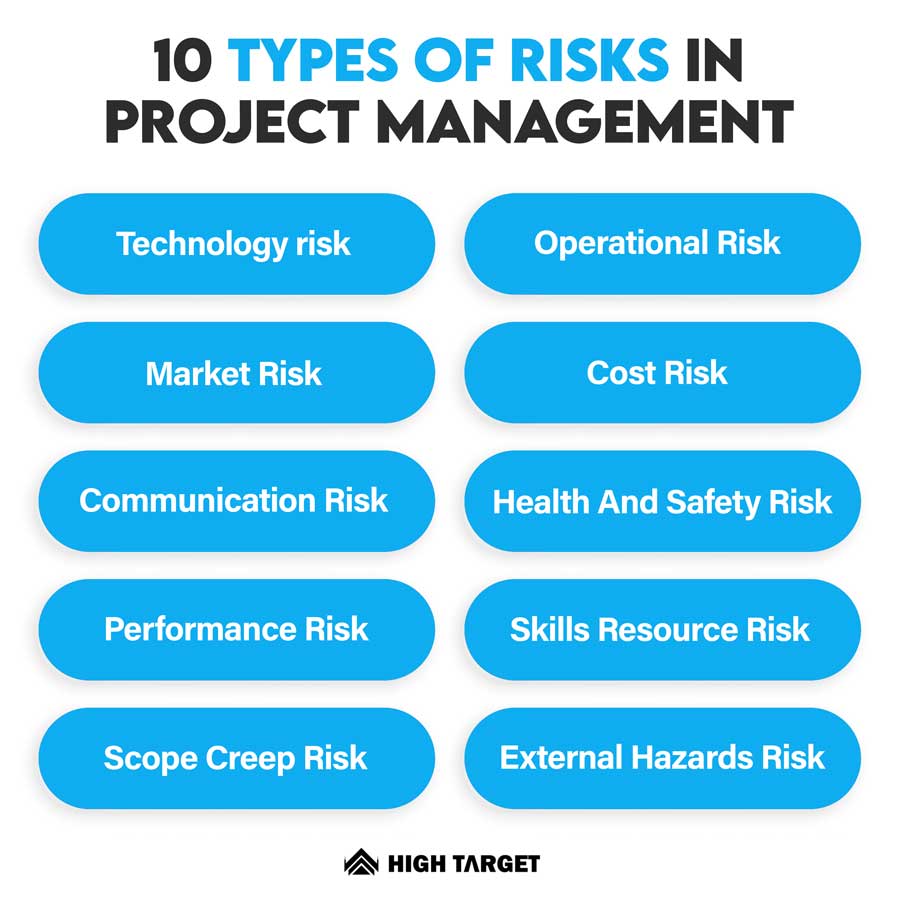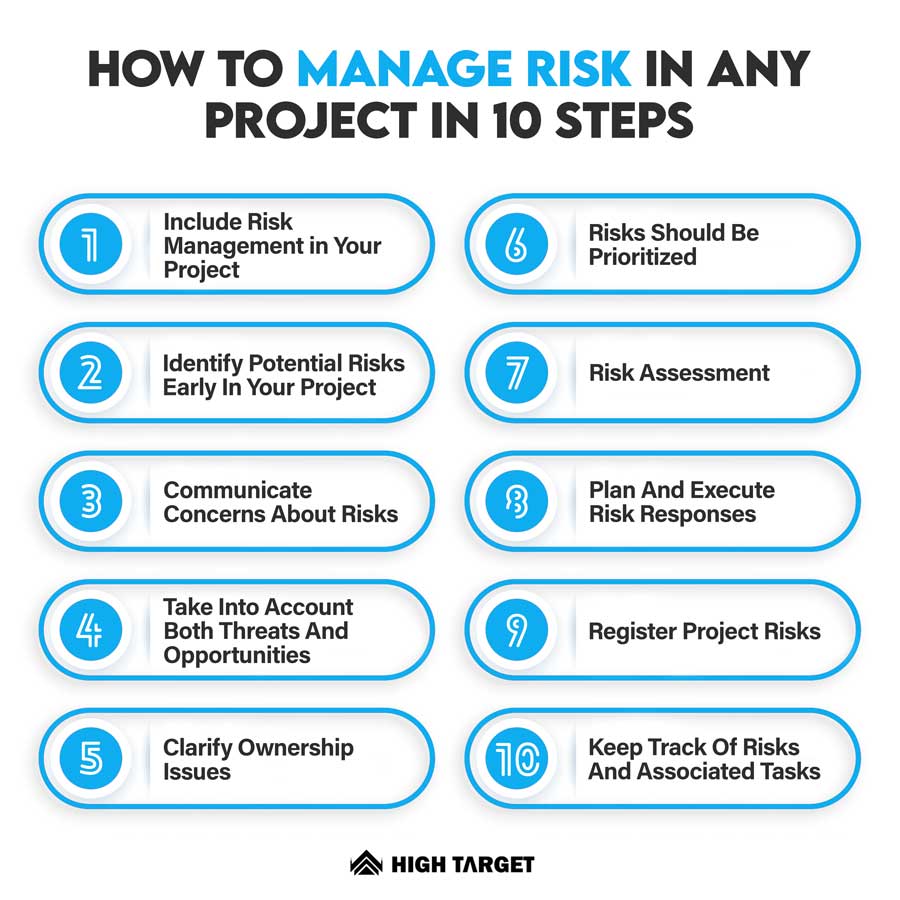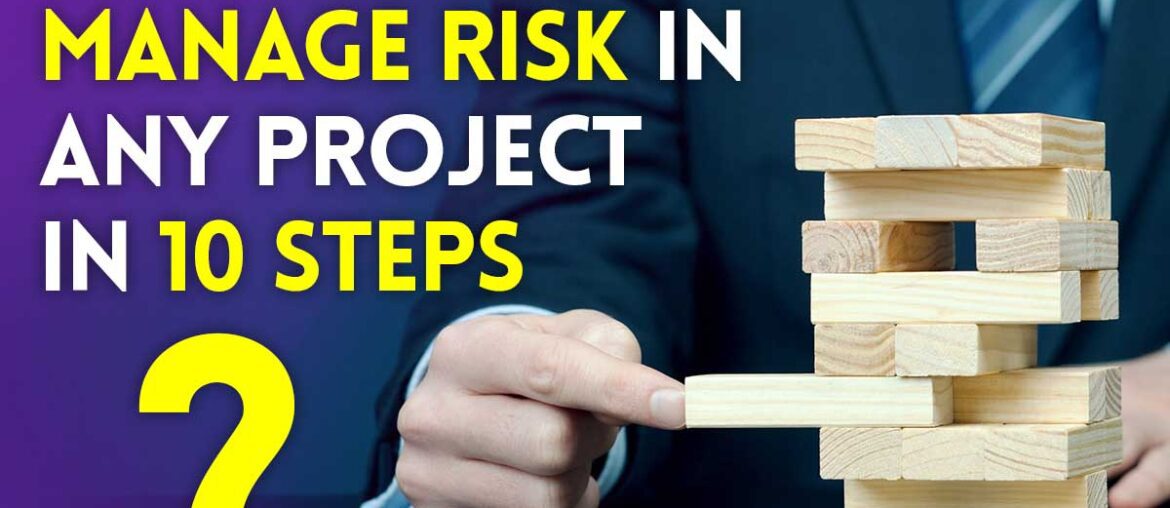
When you begin the project planning process, one of the first questions you should ask yourself is, “What may go wrong?” It may sound negative, but pragmatic project managers understand that this kind of thinking is preventative. Issues will surely arise, and you will need a risk management strategy in place to know how to manage risks when project planning.
But how do you go about resolving the unknown? It may appear to be a philosophical paradox, but don’t worry—there are practical actions you can do.
In this article, we’ll cover topics like “What is risk management and why is it important,” “types of risks in project management,” “common project risks that we face,” and last but least, “ways of steps to manage risk in the project” so you can identify and track them on your project.
Lots to cover, so let’s get started.
What Is Risk Management, And How Does It Help Manage Project Risks?
Risk management is the process of discovering, evaluating, and controlling risks to an organization’s capital and revenues.
These risks arise from a range of sources, including financial uncertainty, legal liabilities, technical challenges, strategic management failures, accidents, and natural disasters.
A successful risk management program assists a company in considering the complete spectrum of risks it faces. Risk management also investigates the relationship between risks and the cascading effect they may have on an organization’s strategic goals.
Because of the emphasis on predicting and understanding risk across a company, this comprehensive approach to risk management is sometimes referred to as enterprise risk management.
In addition to focusing on internal and external threats, enterprise risk management (ERM) emphasizes the need to manage positive risk.
Positive risks are possibilities that, if not accepted, could boost the business value or, on the other hand, harm a firm. Indeed, the goal of any risk management program is not to remove all risks but to preserve and create value for the organization by making sound risk decisions.
“We do not manage risks in order to avoid them. We manage risks so that we know which ones are worth taking, which ones will bring us to our goal, and which ones have a large enough reward for being worth taking, “Alla Valente, governance, risk, and compliance specialist at Forrester Research, affirmed.
As a result, risk management should be integrated into organizational strategy. To connect them, risk management professionals must first identify the organization’s risk appetite or the amount of risk it is ready to absorb to achieve its goals.
The difficult task then becomes determining “which risks fit within the organization’s risk appetite and which require extra controls and measures before they are acceptable,” as outlined by Notre Dame University Senior Director of IT Mike Chapple in his post on risk appetite vs. risk tolerance.
Some risks will be accepted with no additional action required. Others will be reduced, shared with, transferred to a third party, or avoided entirely.
Every firm confronts the danger of unanticipated, damaging occurrences that can cost money or force it to close. Untaken risks can also mean catastrophe, as corporations disrupted by born-digital powerhouses such as Amazon and Netflix will attest.
This risk management reference provides a complete overview of the fundamental concepts, criteria, tools, trends, and arguments driving this dynamic area.
10 Types Of Risks In Project Management

1. Technology risk
Because new and advanced technologies are constantly being developed, the technological side of project management is a complicated task. The technical part of a project poses a significant risk to data security, organizational services, compliance, and information security.
Technology-related risks are more difficult to manage because installing new IT programs frequently necessitates new human training and software acquisition. Other technology risks include service disruptions, which can cause delays and project failure.
2. Market Risk
Market risk is likely when a project fails to deliver the claimed results. Competitors may use this advantage to damage the business and drive it out of the market. Another market risk could occur in commodity and international market fluctuations, which may not benefit the project’s initial forecasts.
Liquidity, credit, and interest rate fluctuations are additional possible market distractions for the project’s product sales.
3. Communication Risk
When you are in charge of a project, you must closely adhere to the work ethic of effective and timely communication. Setting up meetings with stakeholders, such as project donors, allows you to track changes, reassign duties, and promote a cohesive team environment.
With all of the communication channels and gadgets at our disposal, team members might occasionally overlook the crucial components of efficient communication, resulting in data loss or misinterpretation and eventual project disruption.
4. Performance Risk
A perceived performance risk exists when a project is unlikely to produce the desired results. The risk has an intrinsic impact on the entire success of the business. Such an issue may necessitate increased funding and a possible penalty for nonperformance, and it may also leverage the performance of competitors
5. Scope Creep Risk
Uncontrolled and unauthorized changes to the original intended project scope may result in the additional expense of additional features, products, or functions. Almost all projects confront this risk, and occasionally it creates an irreparable issue because some of the extra functions are critical to the project’s success.
6. Operational Risk
If vital operations and core procedures such as production or procurement are not implemented properly, a project may stagnate or fail. The risks could result in a direct or indirect loss due to inadequacies or fail qualitative, quantitative, or strategies. Depending on the type of project, operational risks include:
- IT system risk
- Direct risk of human and process implementation
- Indirect implementation risk due to humans and processes
- Risk to financial capability
7. Cost Risk
A shortfall or mishandling of project money as a result of an inflated budget or other constraints is a threat to the project’s completion. When the project cost exceeds the planned money, the risk may migrate to other operations and labor divisions. Reduced funds may also lead to the occurrence of a scope risk.
8. Health And Safety Risk
Health and safety risks might endanger a company’s compliance with regulations. An organization’s health and safety standards should be checked and analyzed on a regular basis in order to identify potential dangers that could result in losses or fines.
The risk might also result in health difficulties for employees or customers, putting a company’s reputation at risk. The management is responsible for creating ongoing health and safety risk monitoring in the company’s premises and products or services.
9. Skills Resource Risk
Using internal staff is a potentially high-project risk since project operations are sometimes staggered in distinct waves at multiple sites, necessitating in-house personnel attendance. The overlap of the waves creates a possible source of concern.
Another risk that may contribute to the additional cost of employee retraining or transfers is staff ineptitude in multiple project divisions.
10. External Hazards Risk
A possible risk is an unpleasant event that is beyond the project manager’s control. Terrorism, storms, floods, vandalism, earthquakes, and civil instability are examples of such dangers.
When such occurrences occur, a project may stall or be abandoned. Organizations might avoid significant damage or losses caused by an unexpected external threat by using adequate monitoring procedures.
How To Manage Risk In Any Project In 10 Steps
Now we know what risk management and project risk types are. Let’s move into the main content for why you clicked on this article in the first place. Here are 10 steps to manage risk in any project.

1. Include Risk Management in Your Project
The first way is critical to project risk management success. If risk management is not properly embedded in your project, you will not be able to reap the full benefits of this strategy. Companies can have a variety of flawed approaches. Some projects employ no risk management strategy at all.
They are either inexperienced because this is their first project, or they are overconfident that no risks will arise (which, of course, will happen).
Some people naively trust the project manager, especially if he or she appears to be a battered war veteran who has been in the trenches for the last two decades. Professional businesses include risk management in their daily operations, including project meetings and employee training.
2. Identify Potential Risks Early In Your Project
The first stage in project risk management is to identify the risks in your project. This necessitates an open mind that is focused on potential future scenarios. There are two primary sources for identifying risks: people and paper. People are the people of your team who each contribute their own set of experiences and expertise.
Other persons to speak with our professionals outside your project who have experience with the type of project or work you are dealing with. They may disclose some booby traps you will encounter or golden possibilities you may not have considered.
The most popular approaches for discovering the risks that people are aware of are our interviews and team meetings (risk brainstorming). Paper, on the other hand, is a very different story. Projects create a large number of (electronic) papers that carry project risks.
They always do not have that name, but someone who reads closely (between the lines) will locate them. The project strategy, business case, and resource planning are all good places to start. Other categories include previous project blueprints, your company Intranet, and specialized websites.
Are you capable of identifying all project risks before they occur? Almost certainly not. However, using a variety of identification procedures is likely to yield a great majority. If you deal with them appropriately, you will have adequate time to cope with any unforeseen risks that arise.
3. Communicate Concerns About Risks
Failed initiatives reveal that project managers were usually ignorant of the massive hammer that was coming to strike them. The worrying discovery was that the hammer was routinely seen by someone in the project organization but was not reported to the project manager. If you do not want this to occur in your project, you must prioritize risk communication.
An excellent strategy is to include risk communication in all of your tasks. If you have a conference meeting, make project risks part of the default agenda (rather than the last thing on the list!)
This demonstrates that risks are relevant to project management and provides team members with a natural opportunity to discuss them and report new ones.
Another crucial line of communication is between the project manager and the project sponsor or principal.
Concentrate your communication efforts on the major dangers here, and make sure you don’t surprise the employer or the customer! Also, ensure that the sponsor makes judgments on the greatest risks, as some of them typically surpass the project manager’s scope.
4. Take Into Account Both Threats And Opportunities.
Risks in projects have a negative connotation: they are the bad guys who can derail your project. Modern risk management approaches, on the other hand, emphasize positive risks, such as project prospects.
These are the unforeseen happenings that benefit your project and organization. These good guys make your project move faster, better, and more profitably.
Unfortunately, many project teams struggle to finish because they are overburdened with work that must be completed promptly.
This generates a project dynamic in which only negative risks matter (if the team considers any risks at all). Make time to address the opportunities in your project, even if it is only for half an hour. You’re likely to come across a few possibilities with a high payoff that don’t need a significant investment of time or resources.
5. Clarify Ownership Issues
Some project managers believe they are finished once they have compiled a list of risks. However, this is just the beginning. The next stage is to determine who is responsible for which risks! If a risk is not effectively managed, someone must bear the consequences. The trick is simple: assign a risk owner to each risk that you discover.
The risk owner is the individual on your team who is in charge of minimizing this risk for the project. The benefits are really positive. People are usually uneasy at first since they are responsible for some risks, but as time passes, they will act and carry out duties to reduce hazards and increase opportunities.
Ownership exists on another level as well. Someone has to pay the tab if a project is threatened.
This appears to be rational, but it is an issue that must be addressed before a risk emerges. When multiple business units, departments, and suppliers are participating in your project, it is critical to determine who suffers the penalties and must empty his pocketbook.
A significant side effect of explaining risk impacts is that line managers begin to pay attention to a project, especially when a large sum of money is at stake. The ownership problem is equally crucial in terms of project potential. Fights over (unexpected) revenues might become a long-term managerial habit.
6. Risks Should Be Prioritized.
A project manager once informed me, “I approach all risks equally.” This simplifies project management significantly. However, it does not produce the best outcomes possible. Some risks have a greater impact than others. As a result, you should focus your efforts on the risks that can result in the greatest losses or returns.
Check to see if you have any show-stoppers that could derail your project. If so, these should be your first priority. The other dangers can be prioritized either on gut instinct or, more objectively, on a set of criteria.
Most project teams assess the consequences of risk as well as the possibility that it will occur. Whatever method of prioritizing you employ, utilize it consistently and concentrate on the major threats.
7. Risk Assessment
Understanding the nature of a risk is necessary for an effective response. As a result, take some time to examine particular risks and avoid jumping to conclusions without first learning about the risk.
Risk assessment occurs at several levels. If you wish to grasp a risk on an individual level, consider the consequences and the reasons that can lead to it. Looking at the effects, you can describe what happens immediately after a risk arises and what happens as a result of the major impacts or as time passes.
A more extensive study may reveal the order of magnitude influence in a certain effect category, such as costs, lead time, or product quality. Another way to look at risks is to focus on the events that precede a risk occurrence or the risk causes. List the various causes and events that lower or enhance the risk.
An additional degree of risk analysis looks into the entire project. Each project manager must respond to the standard questions concerning the overall budget required and the projected completion date.
If you take risks into consideration, you can run a simulation to show your project sponsor how likely it is that you will finish on a specific date or within a specified time range. A similar process can be carried out for project costs.
The information gathered in a risk analysis will provide useful insights into your project as well as the essential input to discover effective remedies to minimize risks.
8. Plan And Execute Risk Responses
Implementing a risk response is the action that genuinely provides value to your project. You either prevent a threat from arising or mitigate its effects.
Here, execution is critical. The other guidelines have aided you in mapping, prioritizing, and comprehending risks. This will assist you in developing a solid risk response plan that focuses on the big victories.
When dealing with threats, you have three options: risk avoidance, risk minimization, and risk acceptance. Avoiding risks entails organizing your project in such a way that you do not meet a risk. This could imply switching suppliers, adopting new technology, or, in the case of deadly danger, canceling a project. Spending extra money on a failing project is a terrible investment.
The majority of responses are intended to reduce risks. You can strive to avoid risk by influencing the causes or reducing the negative consequences. If you followed rule step 7 correctly (risk analysis), you will have several opportunities to change it. Accepting risk is the final option.
This is an excellent option if the consequences on the project are minor or influencing it becomes difficult, time-consuming, or expensive. Just make sure that accepting a specific risk is a conscious decision.
Responses to risk opportunities are the inverse of those to threats. They will concentrate on identifying, maximizing, or avoiding risks (if opportunities prove to be too small).
9. Register Project Risks
This phase is about bookkeeping (but don’t stop reading). Maintaining a risk journal allows you to track progress and ensure that you don’t overlook a risk or two. It is also an excellent communication tool for informing your team members and stakeholders about what is going on (way 3).
A good risk log incorporates risk descriptions, addresses ownership concerns (step 5), and allows you to conduct some basic assessments of causes and consequences (step 7). Most project managers dislike administrative work, but keeping track of risks pays off, especially if there are a lot of them.
Some project managers do not want to record risks because they believe it will make it easier to blame them if something goes wrong. The opposite is true. When you record project risks and the effective actions you have executed, you generate a track record that no one can deny. Even if a risk arises, that causes the project to be abandoned. Taking on projects entails taking risks.
10. Keep Track Of Risks And Associated Tasks.
The risk register you generated as a result of step 9 will assist you in tracking risks and their associated tasks. Each project manager is responsible for tracking tasks on a daily basis.
The simplest way is to incorporate risky activity into your everyday routine. Risk tasks may be performed to detect or analyze hazards or to produce, select, and implement responses.
Risk tracking differs from task tracking. It concentrates on the current risk situation. Which risks are most likely to occur? Has the importance of risks shifted? Answering these questions will help you focus on the risks that are most important to the value of your project.
Related: 10 Risks Every Entrepreneur Must Take to Succeed In 2022
Conclusion
The article How to Manage Risk in Any Project in 10 Steps explains how to properly apply risk management in your project, among other things. However, keep in mind that you may always improve. As a result, step 11 would be to apply the Japanese Kaizen approach: measure the results of your risk management efforts and continuously adopt adjustments to make it even better.
I wish you the best of luck with your project!












